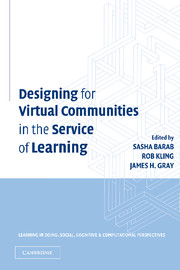Book contents
- Frontmatter
- Contents
- List of Contributors
- Series Foreword
- Foreword
- Preface and Acknowledgments
- In Memoriam
- PART I COMING TO TERMS WITH COMMUNITY
- PART II DESIGNING FOR WEB-SUPPORTED COMMUNITY
- PART III FOSTERING COMMUNITY/MEMBER PARTICIPATION
- 7 The Centrality of Culture and Community to Participant Learning at and with The Math Forum
- 8 An Exploration of Community in a Knowledge Forum Classroom
- 9 Co-Evolution of Technological Design and Pedagogy in an Online Learning Community
- 10 From Ambitious Vision to Partially Satisfying Reality
- PART IV RESEARCHING ONLINE COMMUNITY
- Index
- Titles in the series
- References
9 - Co-Evolution of Technological Design and Pedagogy in an Online Learning Community
Published online by Cambridge University Press: 05 June 2012
- Frontmatter
- Contents
- List of Contributors
- Series Foreword
- Foreword
- Preface and Acknowledgments
- In Memoriam
- PART I COMING TO TERMS WITH COMMUNITY
- PART II DESIGNING FOR WEB-SUPPORTED COMMUNITY
- PART III FOSTERING COMMUNITY/MEMBER PARTICIPATION
- 7 The Centrality of Culture and Community to Participant Learning at and with The Math Forum
- 8 An Exploration of Community in a Knowledge Forum Classroom
- 9 Co-Evolution of Technological Design and Pedagogy in an Online Learning Community
- 10 From Ambitious Vision to Partially Satisfying Reality
- PART IV RESEARCHING ONLINE COMMUNITY
- Index
- Titles in the series
- References
Summary
The design of any piece of technology intended for human use – whether for entertainment, work, or education – is ideally iterative and user-centered. Designers cannot anticipate all the needs of users, but most begin with a prototype and revise it based on user feedback. This is even more true of online learning communities, where designers must understand the needs not just of individual users, but of groups of users and their complex interrelationships as facilitated by the technology. Designers begin with theory, create a prototype, test, and then revise. However, it is not just the technology that can be revised, but also the underlying theory. Technological design and pedagogy have the potential to co-evolve in this new medium.
In this chapter, I will describe in detail one example of this co-evolution: a new perspective on motivation in constructionist learning environments, which evolved through quantitative and qualitative observations of an online learning community called MOOSE Crossing. These observations led to a significant design change to the environment (the addition of a system of “merit badges”), and this in turn led to further reflections on pedagogy.
BACKGROUND: CONSTRUCTIONISM IN A COMMUNITY CONTEXT
In Mindstorms, Seymour Papert has a vision of a “technological samba school.” At samba schools in Brazil, a community of people of all ages gather together to prepare a presentation for Carnival. “Members of the school range in age from children to grandparents and in ability from novice to professional. But they dance together and as they dance everyone is learning and teaching as well as dancing. Even the stars are there to learn their difficult parts” (Papert, 1980, p.178).
Information
- Type
- Chapter
- Information
- Designing for Virtual Communities in the Service of Learning , pp. 239 - 255Publisher: Cambridge University PressPrint publication year: 2004
References
Accessibility standard: Unknown
Why this information is here
This section outlines the accessibility features of this content - including support for screen readers, full keyboard navigation and high-contrast display options. This may not be relevant for you.Accessibility Information
- 21
- Cited by
